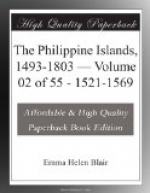Nueva Espana, 1564 (?). The first-appointed admiral of the fleet, Juan Pablo de Carrion, writes to King Felipe in regard to the proposed route. He gives a brief outline of Urdaneta’s opinion that they should sail first to New Guinea. This island he declares “is one that we discovered in the year forty-four.” He describes it as a desolate region, with but scant food, and declares that the voyage thither is dangerous and arduous. His own opinion is that the fleet should take the same course as did Saavedra and Villalobos; “and that the fleet should put in at the Filipinas Islands, which are friendly islands, with whom we have had trade and friendship, and where even eight Spaniards of the fleet in which I sailed remained. They are islands well supplied with all manner of food, and there is much trade there. They are wealthy and large, and have the best location of the entire archipelago. Their language is known, and their ports, and even the names of their principal rulers, with whom we have contracted friendship.... There are islands among them with a circuit of three hundred leagues, and so down to fifty. Those islands that have been seen are eight large ones, without reckoning the small ones between them. They are within sight of one another, so that the most distant of them is not more than ten leagues from another. To the north of them lies the mainland of China, a distance of about two hundred leagues; at about the same distance to the south lies Maluco. And since the route from these lands thither is already known, and we have had experience of it and since it is a land most abundantly provisioned and has much trade, and is rich, I have been of the opinion that we should go thither, inasmuch as this navigation is understood and that we should not seek a new course attended with so great uncertainty and risk.” He recounts that “these islands were discovered first by Magallanes in the year twenty-one,” and afterward by Villalobos, and their secret discovered. “They are islands that the Portuguese have never seen, and they are quite out of the way of their navigation; neither have the latter had any further information of them beyond our drawing or chart. They have the best situation for the return voyage, because they are in north latitude.” He ascribes his not being permitted to accompany the expedition to the divergence of his opinion from that of Urdaneta. The latter has declared that he will not go on the expedition if it takes Carrion’s course; “and as he who goes as general, ... is of his nation and land, and his intimate friend, he wishes to please the father in everything; and as the said general has no experience in these things, nor does he understand anything of navigation, through not having practiced it, he is unable to distinguish one thing from another, and embraces the father’s opinion in everything.” Carrion, in a very brief resume of Urdaneta’s life, declares that he is a man of over sixty. (Tomo ii, no. xxiii, pp. 205-210.)




